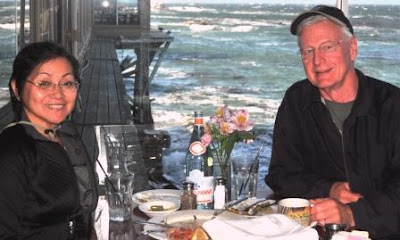Yosemite and Sequoia National Parks are definite must-sees in anyone’s lifetime. But I also got excited about our next stops, what Bill says are quite special places, too: Monterrey Bay through the scenic 17-Mile Drive and the famed town of Carmel-by-the-Sea. And they were. It is wine country, too, but the wineries and vineyards were not where we spent our time. Our days were filled with beautiful scenes.
 On the approach to the 17-Mile Drive is the Lover’s Point, an area of rocks reaching out to the sea and a few cypress trees that drape the landscape. Further on the Drive, which crosses the million-dollar homes of the rich, cypress trees dramatized the sea-drenched coastline. One particular tree has stood alone on a rock jutting out into the bay waters, hence its monicker, The Lone Cypress.
On the approach to the 17-Mile Drive is the Lover’s Point, an area of rocks reaching out to the sea and a few cypress trees that drape the landscape. Further on the Drive, which crosses the million-dollar homes of the rich, cypress trees dramatized the sea-drenched coastline. One particular tree has stood alone on a rock jutting out into the bay waters, hence its monicker, The Lone Cypress. Harbor seals populate the rocks scattered around the waters while sea otters gaily play in the sparkles. They cavorted with birds and many spots have been designated actual marine life sanctuaries. A world-class golf course stands proudly beside the quietly rampaging waves, its golfers braving the gusts for the tee of their lives. And homes brave the forces of nature with rocks that make their roofs sturdier.
Harbor seals populate the rocks scattered around the waters while sea otters gaily play in the sparkles. They cavorted with birds and many spots have been designated actual marine life sanctuaries. A world-class golf course stands proudly beside the quietly rampaging waves, its golfers braving the gusts for the tee of their lives. And homes brave the forces of nature with rocks that make their roofs sturdier. Monterrey Harbor had great shops and Bill and I celebrated our lovely days with a special dinner on a restaurant atop the waters. But the shopping in Carmel was memorable. The small town had the most elegant shops and fascinating galleries just after the famous Mt. Carmel Mission. Luckily, one pretty little group of stores had a quaint courtyard where Bill could relax while I took madly to the shelves.
Monterrey Harbor had great shops and Bill and I celebrated our lovely days with a special dinner on a restaurant atop the waters. But the shopping in Carmel was memorable. The small town had the most elegant shops and fascinating galleries just after the famous Mt. Carmel Mission. Luckily, one pretty little group of stores had a quaint courtyard where Bill could relax while I took madly to the shelves.  The Mission San Carlos Borromeo de Carmelo was founded in 1770 in the nearby settlement of Monterrey, but was relocated to Carmel by Father Serra a year later and became the new Mission Carmel. The Mission at Carmel has significance beyond the history of Father Serra, who is sometimes called the "Father of California". It also contains the state's first library. The town of Carmel was built around the mission.
The Mission San Carlos Borromeo de Carmelo was founded in 1770 in the nearby settlement of Monterrey, but was relocated to Carmel by Father Serra a year later and became the new Mission Carmel. The Mission at Carmel has significance beyond the history of Father Serra, who is sometimes called the "Father of California". It also contains the state's first library. The town of Carmel was built around the mission.Carmel is known for its natural scenery and rich artistic history. Early City Councils were dominated by artists and the town has had several mayors who were poets or actors, including actor-director Clint Eastwood, who was mayor for one term, from 1986 to 1988. In 1905, the Carmel Arts and Crafts Club was formed to support and produce artistic works. After the 1906 San Francisco earthquake the village was inundated with artists from the bay city. Among those who lived in or frequented the village were: Upton Sinclair, Sinclair Lewis, and John Steinbeck.
 The Monterrey Bay Area is romantic and fascinating. But the trip through Big Sur was so inviting!
The Monterrey Bay Area is romantic and fascinating. But the trip through Big Sur was so inviting!









































